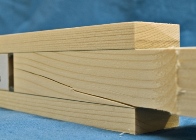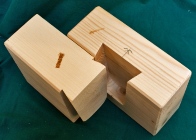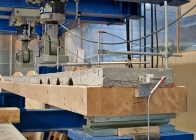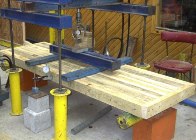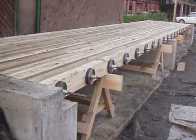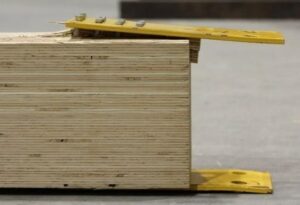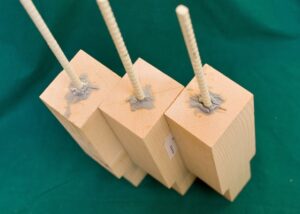Adhesively bonded double lap joints composed were investigated both experimentally and numerically under consideration of various parameters such as overlap length, adhesive layer thickness and type of adhesive. Characteristic material properties of wood such as anisotropy, large scattering of mechanical values and brittle failure complicate the capacity prediction of bonded joints. A probabilistic concept allowed predicting capacities under consideration of the complex stress distributions in the joint. The proposed method has immediate actionable application for the dimensioning of adhesively bonded timber joints.
Rounded dovetail joints
In my PhD thesis I experimentally and numerically studied the structural performance of Rounded Dovetail Connections (RDC). RDC are mainly used to transfer vertical shear forces, but in my tests, I showed that they can carry considerable load in tension and bending and I demonstrated that self-tapping screws significantly improve the performance of RDC under vertical shear. My results showed that it is impractical to determine a set of empirical equations to describe the structural performance of RDC based on basic wood material properties. Therefore I developed a 3D FEA model and worked on a specific failure criterion which took into account the size effect.
Glued Timber-Concrete-Composites
Experimental and numerical investigations on a composite wooden-timber composite beam connected by an adhesive layer elaborated on the possibility to simulate long-term effects of composite materials under varying conditions in climatic conditions. In a long-term investigation with two specimens under constant load, the creep deflection and climatic data were continuously measured. The objective was to provide experimental data to verify a numerical model of the creeping behaviour under changing climatic conditions.
Nail-laminated timber elements
My MSc thesis project was dedicated to the study of nail laminated timber elements for the construction of buildings in Chile. The system consists in nailing together individual boards over their whole lengths and had taken an important position in Europe but was not yet introduced to the Chilean market. The project basically intended to demonstrate the suitability of nail laminated timber elements for the construction of timber houses in Chile.
Pre-stressed timber bridge decks
As Research Assistant in a project in Chile that promoted the use of Timber (FONDEF “Protection by Design in the use of Wood in the Road Infrastructure”), I was involved in the introduction of Stress Laminated Timber Decks to Chile. Stress laminated decks are multifunctional; they transfer loads, provide a dimensionally stable base for the asphalt layer, distribute concentrated loads, and minimize the deflection of the structure. The system is suitable for small dimension timber because of the possible use of but joints these and the costs of production and maintenance are comparably low.
Timber Rivets in Laminated Veneer Lumber
Timber Rivets are oval-shaped nails made from high-strength steel that allow for strong and ductile timber connections. Significant research has been conducted regarding the application of Timber Rivets to Laminated Veneer Lumber (LVL). As a result, the Johansen Yield Model has been complemented with new failure models and design equations that predict brittle failure modes. Recently, new vertically laminated LVL products are available on the marked that can be used in beam applications. The objective of the research was to evaluate the feasibility of using the novel models to predict the failure modes and capacities of Timber Rivet connections in LVL.
Timber Joints with Glued-in FRP Rods
Timber joints with glued-in rods constitute a promising solution for numerous structural applications; in Canada they are, however, not yet widely used, partially for a lack of design guidance and the use of very conservative empirical safety factors. Such joints are used firstly to transfer forces between structural members and secondly to repair damaged parts, and have a series of advantages, e.g., the formation of very stiff connections, good fire properties and improved aesthetics. The research is funded through a NSERC grant.

